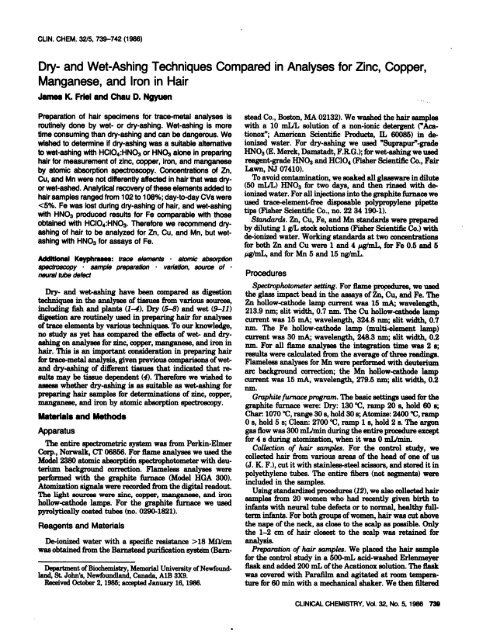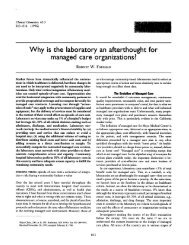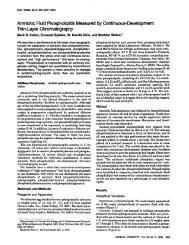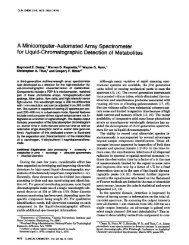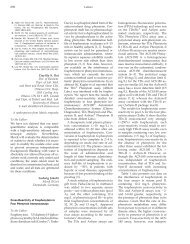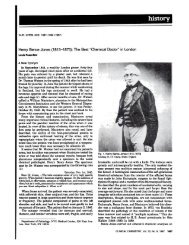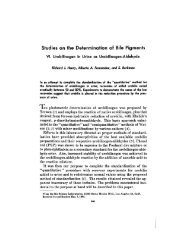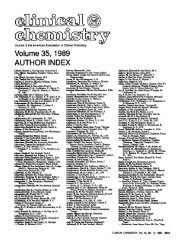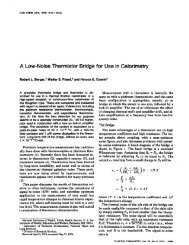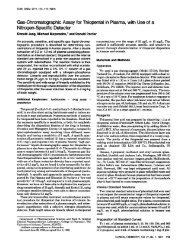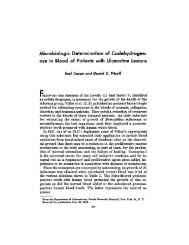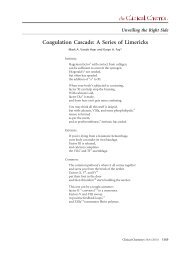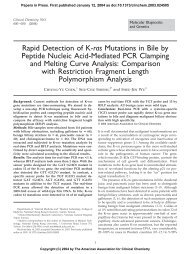Dry- and Wet-Ashing Techniques Compared in ... - Clinical Chemistry
Dry- and Wet-Ashing Techniques Compared in ... - Clinical Chemistry
Dry- and Wet-Ashing Techniques Compared in ... - Clinical Chemistry
Create successful ePaper yourself
Turn your PDF publications into a flip-book with our unique Google optimized e-Paper software.
CLIN.CHEM.32/5, 739-742 (1986)<br />
<strong>Dry</strong>- <strong>and</strong> <strong>Wet</strong>-<strong>Ash<strong>in</strong>g</strong> <strong>Techniques</strong> <strong>Compared</strong> <strong>in</strong> Analyses for Z<strong>in</strong>c, Copper,<br />
Manganese, <strong>and</strong> Iron <strong>in</strong> Hair<br />
James K. Friel <strong>and</strong> Chau D. Ngyuen<br />
Preparation of hair specimens for trace-metal analyses is<br />
rout<strong>in</strong>elydone by wet- or dry-ash<strong>in</strong>g. <strong>Wet</strong>-ash<strong>in</strong>g is more<br />
time consum<strong>in</strong>g than dry-ash<strong>in</strong>g <strong>and</strong> can be dangerous. We<br />
wishedto determ<strong>in</strong>e if dry-ash<strong>in</strong>gwas a suitablealternative<br />
to wet-ash<strong>in</strong>gwith HCIO4:HNO3or HNO3 alone <strong>in</strong> prepar<strong>in</strong>g<br />
hair for measurement of z<strong>in</strong>c, copper, iron, <strong>and</strong> manganese<br />
by atomic absorption spectroscopy. Concentrations of Zn,<br />
Cu, <strong>and</strong> Mn were not differently affected <strong>in</strong> hair that was dryor<br />
wet-ashed. Analytical recovery of these elements added to<br />
hair samples ranged from 102 to 108%; day-to-day CVs were<br />
18 MWcm<br />
was obta<strong>in</strong>ed from the Barnstead purification system (Barn-<br />
Department of Biochemistry, Memorial University of Newfoundl<strong>and</strong>,<br />
St. John’s, Newfoundl<strong>and</strong>, Canada, A1B 3X9.<br />
Received October 2, 1985; accepted January 16, 1986.<br />
stead Co., Boston, MA 02132). We washed the hair samples<br />
with a 10 mLIL solution of a non-ionic detergent (“Acationox”;<br />
American Scientific Products, JL 60085) <strong>in</strong> deionized<br />
water. For dry-ash<strong>in</strong>g we used “Suprapur”-grade<br />
HNO3 (E. Merck, Da<strong>in</strong>stadt, F.R.G.); for wet-ash<strong>in</strong>g we used<br />
reagent-grade HNO3 <strong>and</strong> HC1O4 (Fisher Scientific Co., Fair<br />
Lawn, NJ 07410).<br />
To avoid contam<strong>in</strong>ation, we soaked all glassware <strong>in</strong> dilute<br />
(50 mLIL) HNO3 for two days, <strong>and</strong> then r<strong>in</strong>sed with deionized<br />
water. For all <strong>in</strong>jections <strong>in</strong>to the graphite furnace we<br />
used trace-element-free disposable polypropylene pipette<br />
tips (Fisher Scientific Co., no. 22 34 190-1).<br />
St<strong>and</strong>ards. Zn, Cu, Fe, <strong>and</strong> Mn st<strong>and</strong>ards were prepared<br />
by dilut<strong>in</strong>g 1 g/L stock solutions (Fisher Scientific Co.) with<br />
de-ionized water. Work<strong>in</strong>g st<strong>and</strong>ards at two concentrations<br />
for both Zn <strong>and</strong> Cu were 1 <strong>and</strong> 4 tg/mL, for Fe 0.5 <strong>and</strong> 5<br />
pg/mL, <strong>and</strong> for Mn 5 <strong>and</strong> 15 ng/mL.<br />
Procedures<br />
Spectrophotometer sett<strong>in</strong>g. For flame procedures, we used<br />
the glass impact bead <strong>in</strong> the assays of Zn, Cu, <strong>and</strong> Fe. The<br />
Zn hollow-cathode lamp current was 15 mA; wavelength,<br />
213.9 ma; slit width, 0.7 nm. The Cu hollow-cathode lamp<br />
cm-rent was 15 mA; wavelength, 324.8 nm; slit width, 0.7<br />
nm. The Fe hollow-cathode lamp (multi-element lamp)<br />
current was 30 mA; wavelength, 248.3 nm slit width, 0.2<br />
nm. For all flame analyses the <strong>in</strong>tegration time was 2 a;<br />
results were calculated from the average of three read<strong>in</strong>gs.<br />
Flameless analyses for Mn were performed with deuterium<br />
arc background correction; the Mn hollow-cathode lamp<br />
current was 15 mA, wavelength, 279.5 nm; slit width, 0.2<br />
ma.<br />
Graphite furnace program. The basic sett<strong>in</strong>gs used for the<br />
graphite furnace were: <strong>Dry</strong>: 130 #{176}C, ramp 20 a, hold 60 a;<br />
Char 1070 #{176}C, range 30s, hold 30s; Atomize: 2400 #{176}C, ramp<br />
0 a, hold 5 s; Clean: 2700 #{176}C, ramp 1 s, hold 2 a. The argon<br />
gas flow was 300 mL/m<strong>in</strong> dur<strong>in</strong>g the entire procedure except<br />
for 4 s dur<strong>in</strong>g atomization, when it was 0 mlim<strong>in</strong>.<br />
Collection of hair samples. For the control study, we<br />
collected hair from various areas of the head of one of us<br />
(J. K. F.), cut it with sta<strong>in</strong>less-steel scissors, <strong>and</strong> stored it <strong>in</strong><br />
polyethylene tubes. The entire fibers (not segments) were<br />
<strong>in</strong>cluded <strong>in</strong> the samples.<br />
Us<strong>in</strong>g st<strong>and</strong>ardized procedures (12), we also collected hair<br />
samples from 20 women who had recently given birth to<br />
<strong>in</strong>fants with neural tube defects or to normal, healthy fullterm<br />
<strong>in</strong>fants. For both groups of women, hair was cut above<br />
the nape of the neck, as close to the scalp as possible. Only<br />
the 1-2 cm of hair closest to the scalp was reta<strong>in</strong>ed for<br />
analysis.<br />
Preparation of hair samples. We placed the hair sample<br />
for the control study <strong>in</strong> a 500-mL acid-washed Erlenmeyer<br />
flask <strong>and</strong> added 200 mL of the Acationox solution. The flask<br />
was covered with Parauilm <strong>and</strong> agitated at room temperatare<br />
for 60 mmwith a mechanical shaker. We then filtered<br />
CLINICAL CHEMISTRY, Vol. 32, No. 5, 1986 739
the hair through an acid-washed Buchner funnel connected<br />
to a vacuum aspirator <strong>and</strong> r<strong>in</strong>sed the sample several times<br />
with a total volume of 2 L of de-ionized water before<br />
cover<strong>in</strong>g it <strong>and</strong> leav<strong>in</strong>g it to dry overnight at 55 #{176}C <strong>in</strong> a<br />
dry<strong>in</strong>g oven. Fourteen portions of this control sample of hair<br />
were transferred to acid-washed 15-rnL porcela<strong>in</strong> crucibles,<br />
<strong>and</strong> 28 portions were placed <strong>in</strong> acid-washed 250-mL Pyrex<br />
beakers. All samples weighed between 100 <strong>and</strong> 200 mg.<br />
<strong>Dry</strong> -ash<strong>in</strong>g. Ten of the control hair samples were ashed <strong>in</strong><br />
a muffle furnace (Fisher “Isotemp” muffle furnace, Model<br />
184) for 12 h at 450 #{176}C, after oven-dry<strong>in</strong>g at 250 #{176}C for 2 h.<br />
After they had cooled for 1 h, we removed the samples from<br />
the furnace <strong>and</strong> added five drops of “Suprapur’ HNO3. One<br />
hour later, we returned the samples to the muffle furnace,<br />
where they were heated at 250 #{176}C for 2 h, then ashed at<br />
450 #{176}C for an additional 8 h (11). We aga<strong>in</strong> let the samples<br />
cool for 1 h, then added 1 mL of Suprapur 11N03, <strong>in</strong> 4 mL of<br />
water, to each beaker. After 30 mm, we decanted the<br />
samples <strong>in</strong>to 25-mL volumetric flasks, washed the beakers<br />
with de-ionized water, <strong>and</strong> used the comb<strong>in</strong>ed wash<strong>in</strong>gs to<br />
br<strong>in</strong>g the samples to volume.<br />
<strong>Wet</strong> -ash<strong>in</strong>g. We placed 10 control samples of hair <strong>in</strong> 250-<br />
mL wide-mouthed Pyrex beakers, <strong>and</strong> added 10 mL of<br />
reagent-grade HNO3 to each beaker <strong>and</strong> let these sit overnight.<br />
Ten other control samples of hair were placed <strong>in</strong><br />
similar beakers <strong>and</strong> left to digest <strong>in</strong> 5 mL of HNO3 overnight.<br />
The follow<strong>in</strong>g morn<strong>in</strong>g we added 10 mL of<br />
HC1O4:HNO3 (1:4 by vol) (4) to the latter 10 beakers. All<br />
samples were covered with watch glasses <strong>and</strong> refluxed at<br />
120-140#{176}C for about 4 h until the digests were clear <strong>and</strong> 2-<br />
3 mL of acid rema<strong>in</strong>ed. After cool<strong>in</strong>g for 1 h we decanted the<br />
digested samples <strong>in</strong>to 25-mL volumetric flasks <strong>and</strong> brought<br />
to volume with added r<strong>in</strong>s<strong>in</strong>gs of de-ionized water.<br />
Assess<strong>in</strong>g accuracy <strong>and</strong> precision. Because no certified<br />
hair st<strong>and</strong>ard is currently available, we used U.S. National<br />
Bureau of St<strong>and</strong>ards certified oyster tissue (St<strong>and</strong>ard Reference<br />
Material no. 1566) conta<strong>in</strong><strong>in</strong>g known amounts of Zn,<br />
Cu, Fe, <strong>and</strong> Mn to assess the accuracy of the methods. For<br />
analytical-recovery experiments, we added a known amount<br />
of each metal to four portions of control hair for each of the<br />
dry-ash<strong>in</strong>g, HNO3-ash<strong>in</strong>g, <strong>and</strong> HC1O4:HNO3-ash<strong>in</strong>g procedures.<br />
We also added known amounts of each metal to pure<br />
solutions, which were analyzed without any <strong>in</strong>terven<strong>in</strong>g<br />
ash<strong>in</strong>g steps.<br />
Measur<strong>in</strong>g metals <strong>in</strong> hair samples. For assay of Zn, Cu,<br />
<strong>and</strong> Fe, we aspirated wet- <strong>and</strong> dry-digested samples directly<br />
<strong>in</strong>to the flame. For Mn determ<strong>in</strong>ations, we <strong>in</strong>jected samples<br />
manually <strong>in</strong>to the graphite tube with an Eppendorf pipette.<br />
Sample size was 20 i.L, <strong>and</strong> each sample was analyzed <strong>in</strong><br />
triplicate. We repeated the assays of 10 samples on different<br />
days to assess between-run variation. We also repeated the<br />
assay of one sample 10 times dur<strong>in</strong>g the same day to assess<br />
with<strong>in</strong>-run variation.<br />
Statistical analysis. Differences between hair concentrations<br />
<strong>in</strong> each group were assessed by one-way analysis of<br />
variance (13).<br />
Results<br />
Measured concentrations of z<strong>in</strong>c, copper, <strong>and</strong> manganese<br />
(Table 1) <strong>in</strong> hair treated by dry- <strong>and</strong> wet-ash<strong>in</strong>gs did not<br />
differ. The iron concentration measured <strong>in</strong> hair that was<br />
dry-ashed was lower than that <strong>in</strong> hair that was wet-ashed.<br />
Recovery of known amounts of metals added to pure<br />
solutions was: 99 ± 1% for Zn, 103 ± 3% for Cu, 96 ± 10%<br />
Table 1. Concentrations of ZInc, Copper, Manganese,<br />
<strong>and</strong> Iron In Control Hair Treated by <strong>Dry</strong>- <strong>and</strong> <strong>Wet</strong>-<br />
<strong>Ash<strong>in</strong>g</strong>s<br />
Mean (SD), L9/g dry wt<br />
Zn Cu Mn<br />
<strong>Dry</strong> 216 (4) 44 (1) 0.74 (0.06) 27 (9)<br />
HNO3 216 (28) 42 (5) 0.82 (0.11) 38 (6)b<br />
HNO3:HCIO4 227 (31) 44 (6) 0.77 (0.12) 41 (l2)L<br />
Values with different superscripts are significantly different from each<br />
other at p
<strong>in</strong> determ<strong>in</strong><strong>in</strong>g if dry ash<strong>in</strong>g of hair samples provides a<br />
satisfactory alternative to wet-ash<strong>in</strong>g with either<br />
HC1O4:HNO3 or HNO3 alone.<br />
Z<strong>in</strong>c. Concentrations of Zn <strong>in</strong> hair treated by three<br />
different ash<strong>in</strong>g procedures did not differ (Table 1), suggest<strong>in</strong>g<br />
that dry ash<strong>in</strong>g is a suitable preparation for analysis for<br />
Zn <strong>in</strong> hair. Volatilization losses dur<strong>in</strong>g ash<strong>in</strong>g have not been<br />
reported at the ash<strong>in</strong>g temperature we used, but some Zn<br />
may be reta<strong>in</strong>ed on crucible walls (20). We did not f<strong>in</strong>d any<br />
losses of Zn after dry-ash<strong>in</strong>g, because we evaporated all<br />
samples with HNO3, a method known to improve recovery<br />
(4). Recovery of added Zn (102 ± 7%, Table 2) <strong>and</strong> accuracy<br />
of oyster tissue analysis (Table 3) supports the suitability of<br />
the dry-ash<strong>in</strong>g treatment prior to analysis of Zn <strong>in</strong> hair.<br />
Copper. Concentrations of Cu <strong>in</strong> control hair samples did<br />
not differ among the three treatments (Table 1). Recovery<br />
(108 ± 13%) <strong>and</strong> accuracy of Cu determ<strong>in</strong>ations after dryash<strong>in</strong>g<br />
were comparable to those results obta<strong>in</strong>ed by wetdigestion<br />
(Tables 2 <strong>and</strong> 3). Contam<strong>in</strong>ation with Cu from<br />
porcela<strong>in</strong> crucibles has been reported previously (11) <strong>and</strong><br />
may expla<strong>in</strong> the slightly higher analytical recovery for dryashed<br />
samples than was found for wet-ashed samples. Cu is<br />
not volatile at the ash<strong>in</strong>g temperature we used (20); however,<br />
there have been reports (4) of variable <strong>and</strong> <strong>in</strong>creased<br />
losses of Cu as the temperature of dry-ash<strong>in</strong>g <strong>in</strong>creases<br />
above 400 #{176}C. <strong>Dry</strong>-ash<strong>in</strong>g of hair samples is a reliable<br />
treatment <strong>in</strong> preparation for Cu analysis.<br />
Manganese. Concentrations of Mn <strong>in</strong> hair treated by dryash<strong>in</strong>g<br />
did not differ significantly from those results obta<strong>in</strong>ed<br />
after wet-ash<strong>in</strong>g (Table 1). Mn volatilization dur<strong>in</strong>g<br />
dry ash<strong>in</strong>g is unlikely below 550-600 #{176}C, although some<br />
retention of Mn on crucible walls has been reported (21).<br />
Recovery of Mn is improved with HNO3 (22), <strong>and</strong> the<br />
recovery from porcela<strong>in</strong> crucibles dur<strong>in</strong>g dry-ash<strong>in</strong>g <strong>in</strong> this<br />
experiment was acceptable (108 ± 5%, Table 2). Recovery of<br />
Mn after wet-digestion by HNO3:HC1O4 was high (120 ±<br />
10%, Table 2). This may be attributed to pipett<strong>in</strong>g error or<br />
contam<strong>in</strong>ation, which is a risk because of the very low<br />
concentrations of Mn <strong>in</strong> hair as compared with those of other<br />
metals (Table 4). We do not th<strong>in</strong>k that the slightly lower<br />
values for Mn obta<strong>in</strong>ed dur<strong>in</strong>g dry-ash<strong>in</strong>g are ascribable to<br />
either volatilization or retention of manganese on crucible<br />
walls. Other workers (4) have used ash<strong>in</strong>g aids for manganese<br />
analyses <strong>in</strong> tissues, but this extra step would not be<br />
useful, consider<strong>in</strong>g the low concentrations of manganese <strong>in</strong><br />
hair <strong>and</strong> the correspond<strong>in</strong>gly <strong>in</strong>creased probability of contam<strong>in</strong>ation.<br />
Recently, Guillard et al. (23) reported on manganese<br />
analysis <strong>in</strong> hair after wet-digestion <strong>in</strong> Teflon bombs.<br />
The reported with<strong>in</strong>-run CV (4% vs 8%) <strong>and</strong> recovery (104 ±<br />
9.2% vs 108 ± 5%) of Mn were lower than ours. The slightly<br />
lower f<strong>in</strong>d<strong>in</strong>gs (23) may not justiir the expense of the m<strong>in</strong>iautoclave<br />
(current cost of the Perk<strong>in</strong>-Elmer no. 078486,<br />
$140.00 U.S.) <strong>in</strong> comparison with the cost of porcela<strong>in</strong> or<br />
silica crucibles ($6.00 U.S., Fisher Scientific Co.).<br />
Table 4. Concentrations of Z<strong>in</strong>c, Copper, <strong>and</strong><br />
Manganese In the HaIrof Mothersof Infantswith<br />
Neural Tube Defect or Normal Healthy ChIldren<br />
Neural tube defect (n = 10)<br />
Normal (n = 10)<br />
Mean (SD), pQ/g dry wt<br />
Zn Cu Mn<br />
177 (26) 32 (1) 2.07 (3.5)<br />
193 (30) 30 (21) 0.88 (0.85)<br />
Iron. Measured concentrations of Fe <strong>in</strong> hair were signiiIcantly<br />
lower <strong>in</strong> samples treated by dry-ash<strong>in</strong>g as compared<br />
with wet-ash<strong>in</strong>g (Table 2). Fe concentrations of oyster tissue<br />
analyzed after preparation by the dry-ash<strong>in</strong>g technique<br />
(Table 3) were with<strong>in</strong> the expected range (202 ± 7 tg/g vs<br />
195±34 jtg/g, certified value). Matrix differences may have<br />
accounted for lower measured Fe concentration <strong>in</strong> hair as<br />
compared with the measured Fe concentration <strong>in</strong> oyster<br />
tissue. Some Fe may volatilize dur<strong>in</strong>g dry-ash<strong>in</strong>g, but<br />
previous researchers have reported no Fe losses at 500 or<br />
600#{176}C (24). Retention losses for Fe have also been reported<br />
dur<strong>in</strong>g dry-ash<strong>in</strong>g (27), although our analytical recovery by<br />
the dry-ash<strong>in</strong>g technique (110 ± 9%) was comparable to that<br />
of the HNO3 digestion method (114 ± 14%) <strong>and</strong> higher than<br />
the recovery by the HC1O4:HNO3 digestion technique (100<br />
± 11%, Table 2). Recovery of Fe after dry-ash<strong>in</strong>g was higher<br />
than that found for Zn, Cu, or Mn. Previous researchers<br />
have also reported higher recovery for Fe as compared with<br />
that found for Zn <strong>and</strong> Cu <strong>in</strong> liver (19) <strong>and</strong> hair (5). <strong>Dry</strong>ash<strong>in</strong>g<br />
may not be suitable prior to determ<strong>in</strong><strong>in</strong>g Fe <strong>in</strong> hair.<br />
<strong>Dry</strong>-ash<strong>in</strong>g for Fe has previously been recommended only<br />
for large <strong>and</strong> (or) fatty samples (20). We found that treatment<br />
with HNO3 gave results comparable with those obta<strong>in</strong>ed<br />
by HC1O4:HNO3 digestion (Table 1). Treatment with<br />
HNO3 has previously been reported to be suitable for Fe<br />
analysis <strong>in</strong> hair (25). It should be noted that, if temperatures<br />
exceed 150 #{176}C dur<strong>in</strong>g wet-ash<strong>in</strong>g, some Fe may be lost (4).<br />
Watt<strong>in</strong>g <strong>and</strong> Wordale (4) reported that concentrations of<br />
metals <strong>in</strong> fish tissue after wet. or dry-ash<strong>in</strong>g were comparable.<br />
They suggested that contam<strong>in</strong>ation dur<strong>in</strong>g wet oxidation<br />
may result from the addition of reagents to samples, the<br />
contam<strong>in</strong>ation frequently exceed<strong>in</strong>g the amounts <strong>in</strong> the<br />
sample itself. We used Suprapur-grade HNO3 only dur<strong>in</strong>g<br />
dry-ash<strong>in</strong>g, because each sample required only 1 mL. Suprapur<br />
HC1O4 is not available <strong>and</strong> the large amount of acid<br />
required for wet digestion (10 mL per sample) precludes the<br />
use of Suprapur HNO3 because of the expense. Therefore<br />
blank values obta<strong>in</strong>ed with reagent-grade acid dur<strong>in</strong>g wetash<strong>in</strong>g<br />
were higher than Suprapur blank values obta<strong>in</strong>ed<br />
dur<strong>in</strong>g dry-ash<strong>in</strong>g. Blank values from dry ash<strong>in</strong>g of 18<br />
blanks, calculated <strong>in</strong> micrograms per gram of dry hair, were<br />
low for Zn (0.04), Cu (0.04), <strong>and</strong> Mn (0.02), but were high for<br />
Fe (0.85)-about 5-8% of the usual Fe concentration <strong>in</strong> hair.<br />
A further difficulty dur<strong>in</strong>g wet oxidation is the preparation<br />
of acid-matched st<strong>and</strong>ards, because the amount of acid that<br />
is evaporated differs for each sample.<br />
We suggest that dry-ash<strong>in</strong>g is a suitable treatment for<br />
hair before analyses for Zn, Cu, <strong>and</strong> Mn. <strong>Wet</strong>-digestion with<br />
HNO3 rather than HC1O4:HNO3 is acceptable before the<br />
analysis of Fe <strong>in</strong> hair. Zn, Cu, <strong>and</strong> Mn concentrations <strong>in</strong> hair<br />
analyzed after dry-ash<strong>in</strong>g are presented <strong>in</strong> Table 4 for<br />
mothers who gave birth to <strong>in</strong>fants with neural tube defect<br />
<strong>and</strong> mothers of normal healthy children. The results suggest<br />
a difference <strong>in</strong> trace-metal status of these two groups. A<br />
larger study of these two groups is currently <strong>in</strong> progress.<br />
We thank Dr. Clark Fraser <strong>and</strong> Hillory Vavasour for collect<strong>in</strong>g<br />
the hair samples, Drs. Gene Herzberg <strong>and</strong> L A. W. Feltham for<br />
their helpful comments, <strong>and</strong> Carol Murphy for prepar<strong>in</strong>g this<br />
manuscript. F<strong>in</strong>ancial support was received from the President’s<br />
NSERC Fund.<br />
References<br />
1. Anderson J. <strong>Wet</strong> digestion versus dry ash<strong>in</strong>g for the analysis of<br />
fish tissue for trace metals. At Absorpt Newsi 1972;1l:88-9.<br />
CLINICALCHEMISTRY,Vol.32, No.5, 1986 741
2. Giron HC. Comparison between dry ash<strong>in</strong>g <strong>and</strong> wet digestion <strong>in</strong><br />
the preparation of plant material for atomic absorption analyses. At<br />
Absorpt Newsl 1973;12:28-9.<br />
3. Isaac RA, Johnson WC. Collaborative study of wet <strong>and</strong> dry<br />
ash<strong>in</strong>g techniques for the elemental analysis of plant tissue by<br />
atomic absorption spectrophotometry. J Assoc Off Anal Chem<br />
1975;58:436-40.<br />
4. Watt<strong>in</strong>g HR, Wordale IM. Comparison of wet <strong>and</strong> dry ash<strong>in</strong>g for<br />
the analysis of biological materials by AAS. In: The analysis of<br />
biological materials, Butler LRP, ed., Oxford: Pergamon Press,<br />
1979;69-80.<br />
5. Harrison WW, Yuraeher JP, Benson CA. The determ<strong>in</strong>ation of<br />
trace elements <strong>in</strong> human hair by atomic absorption spectroscopy.<br />
Cl<strong>in</strong> Chim Acts 1969;23:83-91.<br />
6. Hilderbr<strong>and</strong> DC, White DH. Trace-element analyses <strong>in</strong> hair an<br />
evaluation. Cl<strong>in</strong> Chem 1974;20:148-51.<br />
7. Stevens BJ, Determ<strong>in</strong>ation of alum<strong>in</strong>ium, copper <strong>and</strong> z<strong>in</strong>c <strong>in</strong><br />
human hair. Atom Spectr 1983;4:176-8.<br />
8. Peter<strong>in</strong>g HG, Yeager DN, Witherup SO. Trace metal content of<br />
hair I. Z<strong>in</strong>c <strong>and</strong> copper content of human hair <strong>in</strong> relation to age <strong>and</strong><br />
sex. Arch Environ Health 197123:202-7.<br />
9. Eads EA, Lambd<strong>in</strong> CE. A survey of trace metals <strong>in</strong> human hair.<br />
Environ Res 1973;6:247-52.<br />
10. Schroeder HA, Nason AP. Trace metals <strong>in</strong> human hair. J Invest<br />
Dermatol 1969;53:71-8.<br />
11. Salmela S, Vuori E, KilpioJO. The effect of wash<strong>in</strong>g procedures<br />
on trace element content of human hair. Anal Chim Acts<br />
1981;125:131-7.<br />
12. Friel JK, Gibson RS, Balassa R, Watts JL. A comparison of the<br />
z<strong>in</strong>c, copper <strong>and</strong> manganese status of very low birthweight pre-term<br />
<strong>and</strong> full-term <strong>in</strong>fants dur<strong>in</strong>g the first twelve months. Acts Pediatr<br />
Sc<strong>and</strong> 1984;73:596-601.<br />
13. Nie NH, Hull CH, Jenk<strong>in</strong>s JG, Ste<strong>in</strong>bierner K, Bent DH.<br />
Statistical package for the social sciences. New York: McGraw Hill<br />
Inc., 1975.<br />
14. Gibson RS. The trace metal status of some Canadian full term<br />
<strong>and</strong> low birthweight <strong>in</strong>fants at one year of age. J Radioanal Chem<br />
1982;70:175-89.<br />
15. Laker M. On determ<strong>in</strong><strong>in</strong>g trace element levels <strong>in</strong> man: the uses<br />
of blood <strong>and</strong> hair. Lancet 1982;ii:260-2.<br />
16. Kopito L, Biley AM, Shwachman H. Chronic plumbism <strong>in</strong><br />
children. J Am Med Assoc 1969,209:243-8.<br />
17. Valkovic V. Analyses of biological material for trace elements<br />
us<strong>in</strong>g x-ray spectroscopy. Boca Raton, FL: CRC Press, 1980.<br />
18. Cookson JA, Pill<strong>in</strong>g FD. Trace element distribution across the<br />
diameter of human hair. Phys Med Biol 1975;20:1015-20.<br />
19. Cubeils MJS, De la Guardia Cirugeda M, Querada LA. Rapid<br />
determ<strong>in</strong>ation of copper, iron <strong>and</strong> z<strong>in</strong>c <strong>in</strong> liver biopsies. At Spectroec<br />
1984;5:217-22.<br />
20 Tsalev DL. Atomic absorption spectrometry <strong>in</strong> occupational <strong>and</strong><br />
environmental health practice. Volume IL Determ<strong>in</strong>ation of <strong>in</strong>dividual<br />
elements. Boca Raton, FL: CRC Press, 1983.<br />
21. Gorsuch VF. The destruction of organic matter. Oxford: Pergamon<br />
Press, 1970.<br />
22. Casey CE. Concentrations of some trace elements <strong>in</strong> human<br />
<strong>and</strong> cow’s milk Proc Univ Otago Med Sch 1976;54:7-8.<br />
23. Guillard 0, Brugier JC, Piriou A, Menard M, Gombert J, Reiss<br />
D. Improved determ<strong>in</strong>ation of manganese <strong>in</strong> hair by use of a m<strong>in</strong>iautoclave<br />
<strong>and</strong> fla<strong>in</strong>eless atomic absorption spectrometry with Zeeman<br />
background correction; an evaluation of unexpoeed subjects.<br />
Cl<strong>in</strong> Chem 1985;30:1642-5.<br />
24. Koirtyohann SR Hopk<strong>in</strong>s CA. Loss of trace metals dur<strong>in</strong>g<br />
ash<strong>in</strong>g of biological materials. Analyst 1976;101:870-5.<br />
25. Tanaka T, Hayashi Y, Funakawa K, Ishizawa M. Simultaneous<br />
determ<strong>in</strong>ation of Fe <strong>and</strong> Mn <strong>in</strong> human hair by graphite-furnace two<br />
channel AAS. Nippon Kagaku Kaishi 1981;1:169-174. In Japanese,<br />
with abstract <strong>in</strong> English.<br />
742 CLINICALCHEMISTRY,Vol.32, No.5, 1986


